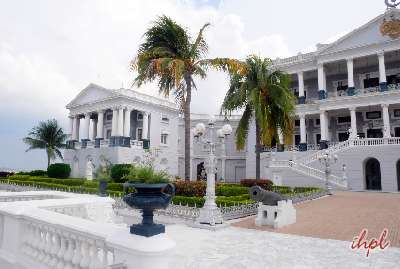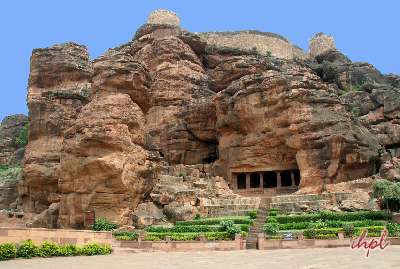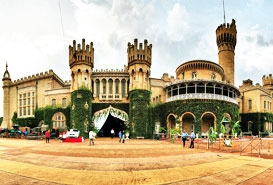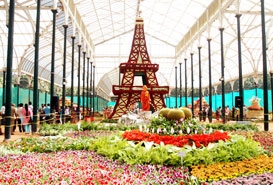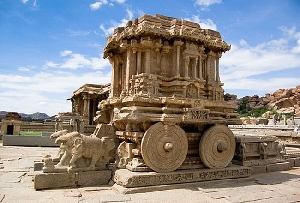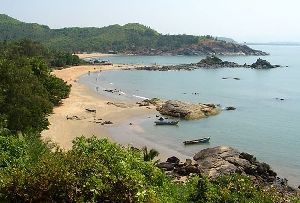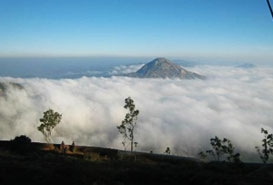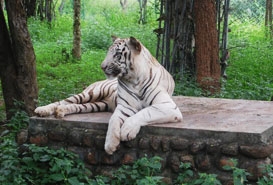Hampi, the ancient capital city of the powerful Vijayanagar Empire, was founded by Harihara and Bukka in 1336, but was annexed by the Muslims in 1565, in the Battle of Talikota. This ancient city of Hampi soon was abandoned and left in ruins. Being a world heritage site, you can feel the pulse of the ancient dynasty that ruled the people of Vijaynagar.
It is the world’s largest open-air museum. The ruins are located in two areas, generally referred to as the Royal Centre. The Archeological Museum in Hampi is under the Archeological Survey of India.
On your tour to Hampi, which is situated in the ravine between two hills, the city offers you a picturesque scenario. The rugged terrain of Hampi has the Tungabhadra River flowing in the north and rocky granite cliffs on other sides. Amidst these natural surrounding stands the ruins of Hampi, an eternal architectural splendor. So aptly, the royal Muslim envoy, Abdul Razaq had commented about Hampi being incomparable to any other, when he traveled to its ruins in 1443.
There are two archeological museums in Hampi exhibiting sculptures, inscriptions and artifacts from the period between 1480 and 1680 when Adil Shahi Sultans ruled Deccan. The exhibits include miniature paintings, manuscripts, porcelain artifacts, coins, carpets and armory. Stone sculpture and inscriptions in Devanagari, Kannada, Arabic and Persian are also found in the Archeological Museum in Hampi. Architectural specimens of the structures in Aihole and Badami are also displayed in the second archeological museum of Hampi.
Hampi Tour Packages
Things To Do in Karnataka
- Hampi Tourism
- Best Time to Visit Hampi
- How to Reach Hampi
- Coracle Crossings Hampi
- Historical Places in Hampi
- Achyutaraya Temple Hampi
- Balakrishna Temple Hampi
- Elephant Stables, Hampi
- Hazara Rama Temple, Hampi
- Kadalekalu Ganesha Temple Hampi
- Lakshmi Narasimha Temple Hampi
- Monolithic Bull Hampi
- Queens Bath Hampi
- Stone Doors Hampi
- Sule Bazaar Hampi
- Ugra Narasimha Statue Hampi
- Virupaksha Temple Hampi
- Vittala Temple Complex Hampi
- Museums in Hampi
- Rock Climbing in Hampi
- Famous Cities in Karnataka
- Climate in Karnataka
- Culture in Karnataka
- History of Karnataka
- Shopping in Karnataka
- Fairs and Festivals
- Fairs and Festivals in Karnataka
- Hampi Festival Karnataka
- Kambala Festival in Karnataka
- Mysore Dasara, Karnataka
- Pattadakkal Dance Festival
- Pongal Festival Karnataka
- Badami Tourism
- Agastya Lake Badami
- Aihole in Karnataka
- Badami Fort Badami
- Bhutanatha Group of Temples
- Cave Temples in Badami
- Bengaluru Tourism
- Temples in Bangalore
- Art of Living International Center
- Attara Kacheri in Bangalore
- Bangalore Fort
- Bangalore Palace
- Bannerghatta National Park
- Bull Temple in Bangalore
- Cubbon Park in Bangalore
- Gardens in Bangalore
- Gavi Gangadeshwara Temple in Bangalore
- Government Museum in Bangalore
- HAL Aerospace Museum in Bangalore
- Innovative Film City in Bangalore
- ISKCON in Bangalore
- Lal Bagh Botanical Garden in Bangalore
- National Gallery of Modern Art
- Suryanarayana Temple in Bangalore
- Tipu Sultans Palace in Bangalore
- Visvesvaraya Industrial & Technological Museum
- Wonderla Amusement Park in Bangalore
- Tumkur Tourism
- Udupi Tourism
- Bellary Tourism
- Bidar Tourism
- Bijapur Tourism
- Chikmagalur Tourism
- Chitiradurga Tourism
- Coorg Tourism
- Tribal Life And Culture In Coorg
- Abbey Falls in Coorg
- Brahmagiri Hill in Coorg
- Bylakuppe in Coorg, Karnataka
- Chelavara Falls in Coorg
- Dubare Elephant Camp in Coorg
- Igguthappa Temple in Coorg
- Iruppu Falls Coorg
- Madikeri Fort in Coorg, Karnataka
- Mandalpatti View Point in Coorg
- Omkareshwara Temple
- Rajas Seat in Coorg
- Sai Sanctuary in Coorg
- Tadiandamol Peak in Coorg
- Tala kaveri in Coorg
- Tibetan Monasteryin Coorg
- Unchalli Falls in Coorg
- Davangere Tourism
- Gokarna Tourism
- Gulbarga Tourism
- Halebid Tourism
- Hassan Tourism
- Hospet Tourism
- Hubli Tourism
- Karwar Tourism
- Madikeri Tourism
- Mangalore Tourism
- Kadri Manjunath Temple Mangalore
- Kudroli Gokarnath Temple Mangalore
- Moodabidri Jain Temple Mangalore
- Someshwar Beach Mangalore
- St. Aloysius Chapel Mangalore
- Sultan Battery Mangalore
- Tannirbhavi Beach Mangalore
- Ullal Beach Mangalore, Karnataka
- Manipal Tourism
- Mysore Tourism
- Bandipur National Park
- Brindavan Gardens in Mysore
- Chamundi Hills in Mysore
- Jaganmohan Palace in Mysore
- Karanji Lake in Mysore
- Keshava Temple in Bangalore
- Melukote in Mysore
- Mysore Dasara
- Mysore Palace
- Mysore Zoo
- Nagarhole National Park
- Rail Museum in Mysore
- Ranganathittu Bird Sanctuary
- Sri Ranganathaswamy Temple
- St. Philomena Church in Mysore
- Pattadakal Tourism
- Raichur Tourism
- Sakleshpur Tourism
- Shimoga Tourism
- Shravanabelagola Tourism
- Sringeri Tourism
- Srirangapatna Tourism
- Tourist Attractions in Karnataka
- Beaches in Karnataka
- Devbagh Beach Karwar, Karnataka
- Gokarna Beach
- Karwar Beach Karnataka
- Kapu Beach Karnataka
- Malpe Beach Udupi, Karnataka
- Mangalore Beach
- Marawanthe Beach Udupi, Karnataka
- Murudeshwar Beach Karnataka
- Netrani Island Beach Karnataka
- St. Mary Island Beach Karnataka
- Suratkal Beach Karnataka
- Ullal Beach Mangalore, Karnataka
- Hill Stations in Karnataka
- Agumbe Hill Station Karnataka
- Kemmangundi Hill Station Karnataka
- Kodachadri Hill Station Karnataka
- Kudremukh Hill Station
- Kundadri Hill Station Karnataka
- Nandi Hills Karnataka
- Yana Hill Station Karnataka
- Monuments in Karnataka
- Bidar Fort Bidar, Karnataka
- Vidhan Soudha Bangalore
- Citadel Bijapur
- Daria Daulat Bagh Mysore
- Gol Gumbaz Bijapur
- Gulbarga Fort Karnataka
- Historical Monuments in Karnataka
- Ibrahim Rouza Bijapur
- Jaganmohan Palace And Art Gallery
- Kittur Chennamma Fort Kittur, Karnataka
- Srirangapatna Fort
- Statue of Gomateshwara Sravanbelgola Karnataka
- Group of Monuments at Pattadakal
- Museums in Karnataka
- Archaeological Museum Hampi
- Folklore Museum in Mysore
- Indira Gandhi Manav Sangrahalaya Mysore
- Temples in Karnataka
- Sri Biligiri Ranganatha Swamy Temple
- Cave Four of Cave Temples Badami
- Cave One of Cave Temples Badami
- Cave three Of Cave Temples Badami
- Cave two Of Cave Temples Badami
- Chennakeshava Temple Belur
- Devi Mookambika Temple Mangalore
- Gavi Gangadeshwara Temple in Bangalore
- Hidimbeshwar Temple
- Hoysaleshwar Temple Halebid
- Keshava Temple in Bangalore
- Mahakuta Temple Badami
- Mallikarjuna Temple in Bangalore
- Omkareshwara Temple
- Sri Durga Temple Aihole
- Temples in Badami
- Temples in Hampi
- Virupaksha Temple Pattadakal(Pampapathi temple Hampi)
- Waterfalls in Karnataka
- Abbey Falls in Coorg
- Hebbe Falls Chikamagalur, Karnataka
- Honnemaradu in Karnataka
- Iruppu Falls Coorg
- Jog Falls in Karnataka
- Kalhatti Falls Chikmagalur
- Lalguli Falls Gokarna, Karnataka
- Magod Falls Dandeli, Karnataka
- Nisargadhama Falls Coorg
- Sathodi Falls Dandeli, Karnataka
- Shivasamudram Falls Karnataka
- Unchali Falls Karnataka




